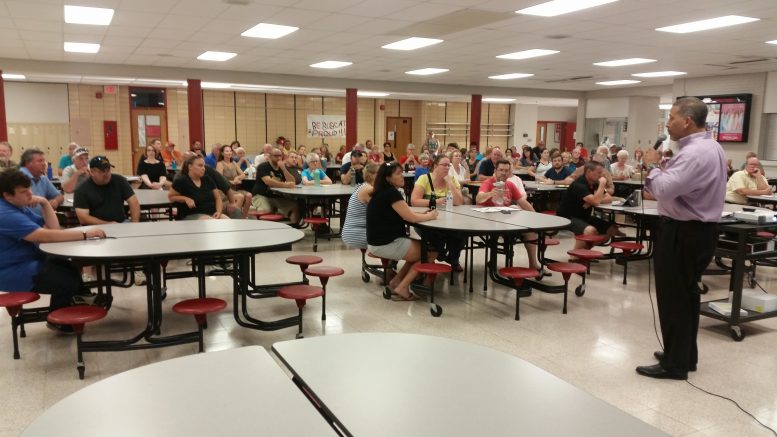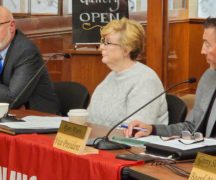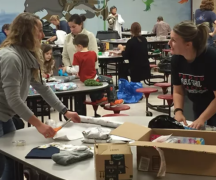By JAN LARSON McLAUGHLIN
BG Independent News
Bowling Green task force members put their first drops of sweat equity into the future of their school district Tuesday evening. They gathered in the hot high school cafeteria to take the initial steps toward a school building solution that two bond issue attempts failed to solve.
“This is a great opportunity for the community,” said David Conley, a financial consultant hired by the school district to help find a solution. “It’s a wonderful opportunity to restart the clock.”
Approximately 130 citizens signed up to serve on two task forces – one focused on school facilities, the other on school finances. When done with their work, the task forces will make recommendations to the school board of how to proceed on building issues.
“You drive the train on this,” Conley said. “You can conclude that there’s no need for anything.”
To help the facilities task force decide the future of Bowling Green school buildings, Conley introduced three members of Fanning Howey, a firm of architects, engineers, planners and former school administrators who specialize in schools.
The firm has assisted more than 100 Ohio school districts, including Eastwood, North Baltimore and Northwood in Wood County.
Three members of the firm are volunteering their time to work with the Bowling Green facilities task force. Architects Steve Wilczynski and Dan Obrynba, plus former school superintendent Tim Hamilton made their pitch to the citizens.
Some citizens expressed skepticism about the firm’s motives for volunteering. Obrynba explained that this is the first time for them to volunteer on a job – however, he added that if they do a good job, they will have earned themselves a chance to work on whatever building project the district decides is right for Bowling Green.
Others questioned their objectivity when it comes to deciding on renovating old buildings versus constructing new ones.
Hamilton said he has been involved with the whole gambit – from fixing up and adding on, to full renovations and building new.
Wilczynski estimated 60 to 65 percent of the firm’s work is new buildings, with 35 to 40 percent being renovations.
“The reality is, it’s your solution,” Obrynba said.
The three men said they approach each project with open minds.
“We’ve not intentionally tried to find out a lot about your school district,” Wilczynski said.
The task force process will work like this – the group will collect goals and visions from task force members, connect with the community, create options, then complete a plan. The process is not a straight line, Wilczynski warned.
“We don’t have any idea where this is going to go – but we can help you get there,” he said.
The task force will look at the physical conditions of the district’s buildings, plus determine their education adequacy.
“Is the building in the way of teaching,” Obrynba said.
The members will tour the schools, and talk about future possibilities.
“What do you want your kids to have,” Obrynba said.
The group will study enrollment history and projections, plus examine the economic issues facing the community.
Above all, the task force must address the “multiple elephants” in the room – which all districts have, Hamilton said.
“We will flip over every rock and stone, and figure out what’s under there,” he said.
Retired teacher Roger Mazzarella said of the “elephants” that needs to be discussed is the fact that fewer than half of the district’s residents voted on the last two bond issues.
Hamilton said his firm could help with that. “We can pick apart your voter analysis for Bowling Green,” he said.
The goal of the task force is to set a vision, provide defensible data, and build a consensus.
Meetings will be held to connect with the community where they are – services groups, booster groups, churches, through surveys, social media, mobile applications.
“We are truly trying to do what’s best for the students of Bowling Green,” Wilczynski said.
The facilities task force will have to determine if its building proposal is affordable for district residents. And it will have to decide if the district should work with the Ohio Facilities Construction Commission.
Wilczynski could offer few definitive answers to citizens’ questions about the OFCC funding. When told where Bowling Green ranks on the state list, he added “you’re not eligible right now,” and the state is not likely to give an estimate on when funding might be available, he said.
By voice vote, the citizens at Tuesday’s meeting gave the Fanning Howey firm their blessing to start interacting with school officials to gather information. After that is done, facilities task force members will be contacted through email about a meeting schedule.
The task force process will take an estimated six months to a year.
“You’re going to own the solution,” Obrynba said.

David Conley talks to district task force members.
The financial task force will have to wait for the facilities task force to make some decisions before it can proceed with more detailed plans. However, the financial task force can start with preliminary research by identifying building funding options, such as income tax, property tax, new business development taxes, or a combination of those.
The financial task force will be facilitated by Conley, who is being paid $40,000 for a year’s work by the school district. Conley, whose expertise is in government finance, has worked with more than 125 school districts in Ohio.
The task force will investigate each funding option for its viability, while making sure the district still has enough operating funds.
“We’ll actually delve into the finances of the residents of the community,” Conley said, to study their existing tax burdens. The group will also identify ways to reduce the need for new taxes.
“So you can say to your neighbors that you looked at everything,” Conley said.
The next meeting of the financial task force will be Sept. 19, at 7 p.m., with the location yet to be determined.
Conley set some ground rules for task force members.
“This is an emotionally charged issue in the community,” he said.
First, smile. “This is a once in a lifetime chance. There are no do-overs,” he said.
Second, work earnestly. “Do it with your heart. Do not take it lightly.”
Next, remember that every person has a point and deserves to be heard. “Respect each other,” he said.
Conley stressed the need for the task forces to stay on track, and focus on issues not people. He asked that members be open to new concepts, and agree to learn first before forming opinions.
Members will also be asked to attend all the meetings, or get the information from the meetings they missed. Those who don’t commit to the task force work will not be allowed to vote on the recommendations to the board, Conley said.





